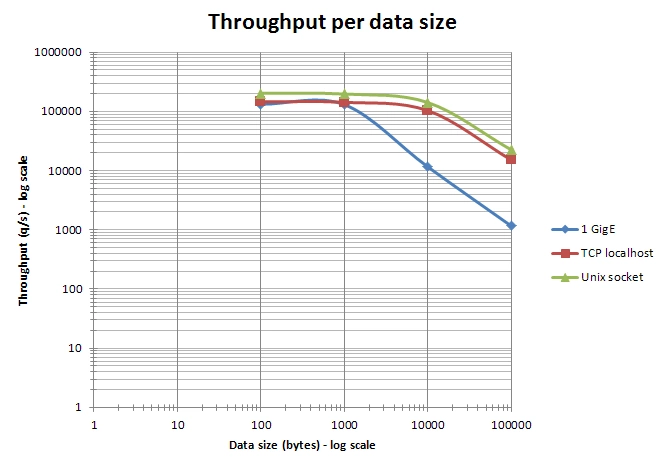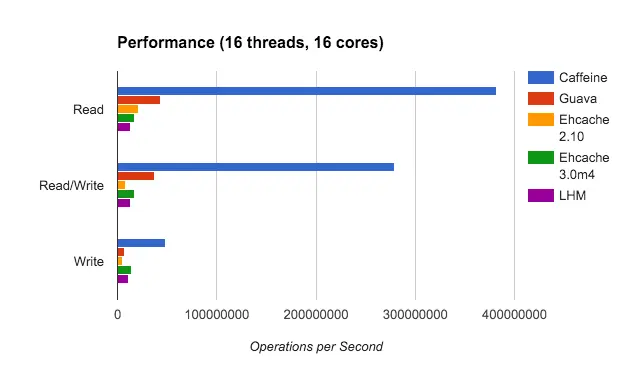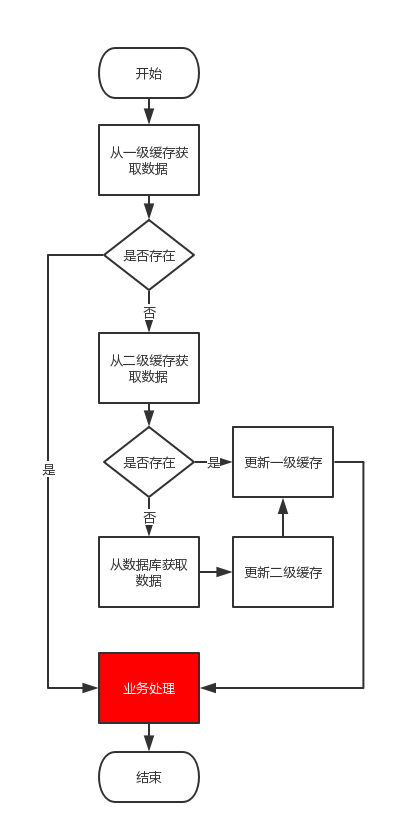为什么多级缓存
缓存的引入是现在大部分系统所必须考虑的
- redis 作为常用中间件,虽然我们一般业务系统(毕竟业务量有限)不会遇到如下图 在随着 data-size 的增大和数据结构的复杂的造成性能下降,但网络 IO 消耗会成为整个调用链路中不可忽视的部分。尤其在 微服务架构中,一次调用往往会涉及多次调用 例如pig oauth2.0 的 client 认证

- Caffeine 来自未来的本地内存缓存,性能比如常见的内存缓存实现性能高出不少详细对比。

综合所述:我们需要构建 L1 Caffeine JVM 级别内存 , L2 Redis 内存。
设计难点
目前大部分应用缓存都是基于 Spring Cache 实现,基于注释(annotation)的缓存(cache)技术,存在的问题如下:
- Spring Cache 仅支持 单一的缓存来源,即:只能选择 Redis 实现或者 Caffeine 实现,并不能同时使用。
- 数据一致性:各层缓存之间的数据一致性问题,如应用层缓存和分布式缓存之前的数据一致性问题。
- 缓存过期:Spring Cache 不支持主动的过期策略
业务流程

如何使用
- 引入依赖
<dependency><groupId>com.pig4cloud.plugin</groupId><artifactId>multilevel-cache-spring-boot-starter</artifactId><version>1.0.1</version></dependency>
- 开启缓存支持
@EnableCachingpublic class App {public static void main(String[] args) {SpringApplication.run(App.class, args);}}
- 目标接口声明 Spring Cache 注解
@Cacheable(value = "get",key = "#key")@GetMapping("/get")public String get(String key){return "success";}
性能比较
为保证性能 redis 在 127.0.0.1 环路安装
- OS: macOS Mojave
- CPU: 2.3 GHz Intel Core i5
- RAM: 8 GB 2133 MHz LPDDR3
- JVM: corretto_11.jdk | Benchmark | Mode | Cnt | Score | Units | | —- | —- | —- | —- | —- | | 多级实现 | thrpt | 2 | 2716.074 | ops/s | | 默认 redis | thrpt | 2 | 1373.476 | ops/s |
代码原理
- 自定义 CacheManager 多级缓存实现
public class RedisCaffeineCacheManager implements CacheManager {@Overridepublic Cache getCache(String name) {Cache cache = cacheMap.get(name);if (cache != null) {return cache;}cache = new RedisCaffeineCache(name, stringKeyRedisTemplate, caffeineCache(), cacheConfigProperties);Cache oldCache = cacheMap.putIfAbsent(name, cache);log.debug("create cache instance, the cache name is : {}", name);return oldCache == null ? cache : oldCache;}}
- 多级读取、过期策略实现
public class RedisCaffeineCache extends AbstractValueAdaptingCache {protected Object lookup(Object key) {Object cacheKey = getKey(key);// 1. 先调用 caffeine 查询是否存在指定的值Object value = caffeineCache.getIfPresent(key);if (value != null) {log.debug("get cache from caffeine, the key is : {}", cacheKey);return value;}// 2. 调用 redis 查询在指定的值value = stringKeyRedisTemplate.opsForValue().get(cacheKey);if (value != null) {log.debug("get cache from redis and put in caffeine, the key is : {}", cacheKey);caffeineCache.put(key, value);}return value;}}
- 过期策略,所有更新操作都基于 redis pub/sub 消息机制更新
public class RedisCaffeineCache extends AbstractValueAdaptingCache {@Overridepublic void put(Object key, Object value) {push(new CacheMessage(this.name, key));}@Overridepublic ValueWrapper putIfAbsent(Object key, Object value) {push(new CacheMessage(this.name, key));}@Overridepublic void evict(Object key) {push(new CacheMessage(this.name, key));}@Overridepublic void clear() {push(new CacheMessage(this.name, null));}private void push(CacheMessage message) {stringKeyRedisTemplate.convertAndSend(topic, message);}}
- MessageListener 删除指定 Caffeine 的指定值
public class CacheMessageListener implements MessageListener {private final RedisTemplate<Object, Object> redisTemplate;private final RedisCaffeineCacheManager redisCaffeineCacheManager;@Overridepublic void onMessage(Message message, byte[] pattern) {CacheMessage cacheMessage = (CacheMessage) redisTemplate.getValueSerializer().deserialize(message.getBody());cacheMessage.getCacheName(), cacheMessage.getKey());redisCaffeineCacheManager.clearLocal(cacheMessage.getCacheName(), cacheMessage.getKey());}}
源码地址
https://github.com/pig-mesh/multilevel-cache-spring-boot-starter


